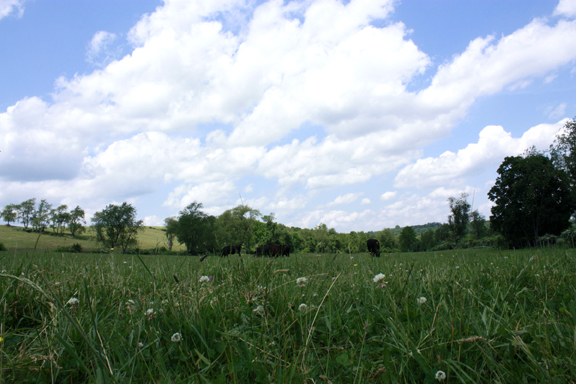There are many opinions and assumptions about beef floating around the wild blue yonder. Determining fact from fiction takes up valuable time and energy in an age of conservation and eco-friendly living.
Conserve your resources. It’s time to do some myth-bustin’.
MYTH: Grass-fed beef is healthier and more eco-friendly than grain-finished beef.
FACT: All beef is an excellent source of zinc, iron and protein, plus many B vitamins. Did you know there is no significant difference between omega three levels in grass-fed and grain-finished beef. And it’s important to note that grass-fed beef does not mean free from added hormones and antibiotics.
As for energy use, greenhouse gas emissions per pound of beef are increased three-fold in grass-fed cattle. Why? Because it takes longer to get them to market weight when they’re fed exclusively on pasture.
Here’s the key thing to remember: All of today’s beef cattle are grass fed. They begin life at their mother’s side, frolicking around the pasture. As they grow older — think teenager stage — they are moved to another pasture with cattle of the same age where they eat grass. It’s the last 150 days of the cycle that cattle are moved to a feedlot. There they are carefully tended and finished on a diet of grains and nutrients. It’s a happy, healthy process that is efficient and resourceful.


Great myth to bust ! I hear that one a lot, and then I try my best to set the record straight. I will use this article for my next “presentation”.
It”s that 150 days on the feedlot that concerns me more than grass vs. feed, although I”m inclined to favor grass fed. How is what your farmers practice different from the factory farming/ranching I want to avoid? If they”re on a feedlot for three months, how do they avoid the problems that cause so many cattle to be stuffed with antibiotics during that period? I”m hoping you”ll be able to reassure me that I can purchase your beef from a nearby butcher shop without being concerned about these issues, but otherwise, I”ll have to keep looking.
Two myth or fact followups:
1) is it myth or fact that there is both a nutritional and consistency difference between the
fat that a bear, hog, or elk, for instance, puts on in the late summer and fall of each year while free-range forging in the wild for leaves, grasses, acorns, etc.( a fat presumable to replicate all the essential nutrients necessary to sustain life during the lean winter by gradual reabsorption until spring) and the fat accumulated by an animal of the same spiecie who accumulates fat in a physically confined no selective choice, single source feed?
2) in computing the “energy use” and greenhouse emissions per pound of beef grown and concluding that grass raised cattle had a three-fold increase over feed-lot raised beef
a) did you consider the fed cattle “energy use” factors like mixing and shipping and applying commercial fertilizers, and seed and herbicides; harvesting, drying, storing, shipping, the grain and other constituents of the feed; the formulating, mixing, storing, shipping and storing again the feed at the feed lot; the feeding of the cattle and the enormous clean up storeage and diposal activities essential thereafter for urine and fecal matter and the disposal of fatalities? And b) what rate of daily gain did you use for grass raise cattle and feedlot raised cattle? Thanks for covering this interesting topic.